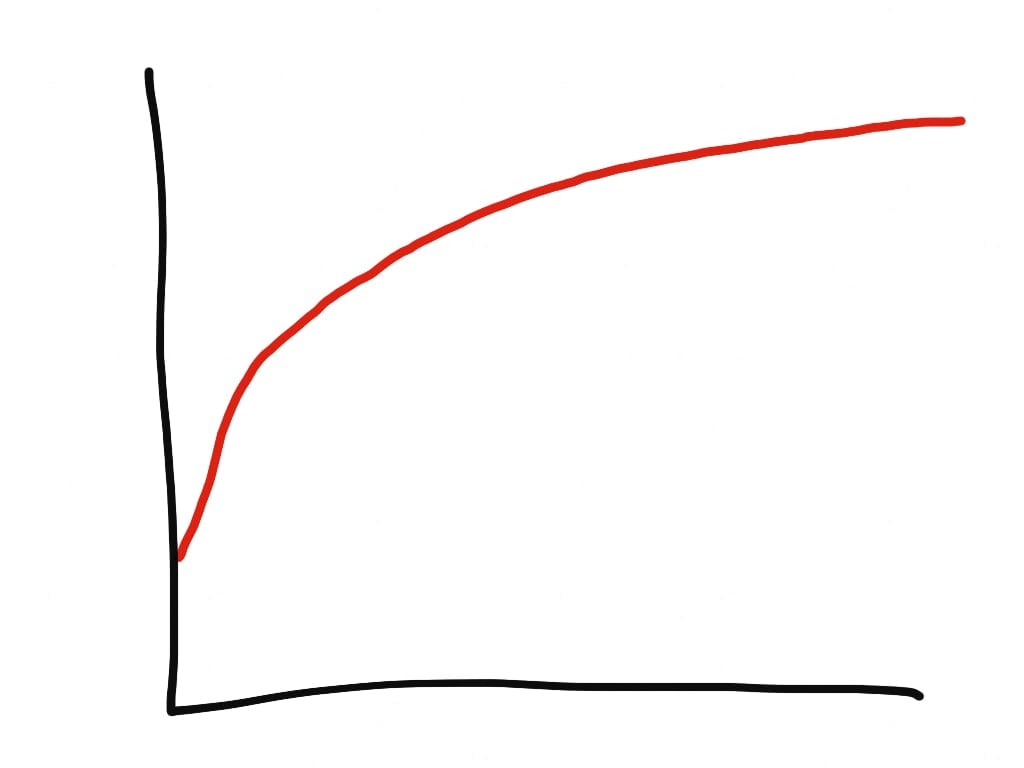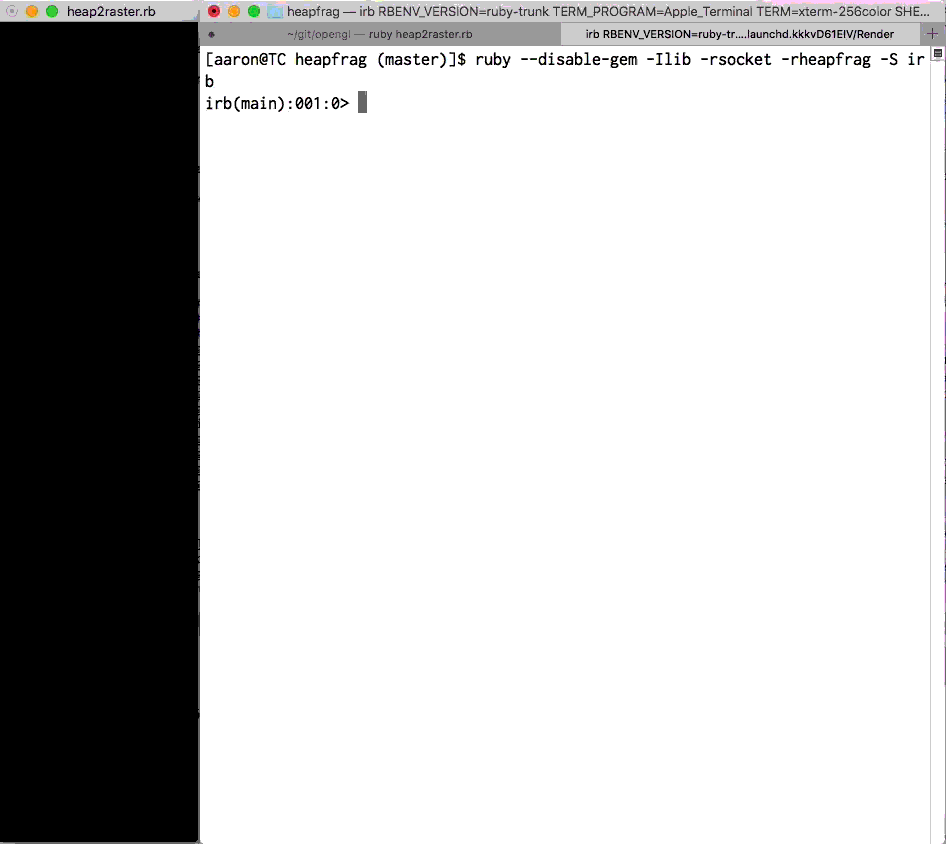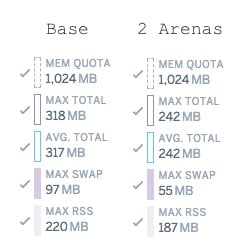Malloc Can Double Multi-threaded Ruby Program Memory Usage

Sometimes, it really is that simple.
It’s not every day that a simple configuration change can completely solve a problem.
I had a client whose Sidekiq processes were using a lot of memory - about a gigabyte each. They would start at about 300MB each, then slowly grow over the course of several hours to almost a gigabyte, where they would start to level off.
I asked him to change a single environment variable: MALLOC_ARENA_MAX. “Please set it to 2.”
His processes restarted, and immediately the slow growth was eliminated. Processes settled at about half the memory usage they had before - around 512MB each.

Actually, it’s not that simple. There are no free lunches. Though this one might be close to free. Like a ten cent lunch.
Now, before you go copy-pasting this “magical” environment variable into all of your application environments, know this: there are drawbacks. You may not be suffering the problem it solves. There are no silver bullets.
Ruby is not known for being a language that’s light on memory use. Many Rails applications suffer from up to a gigabyte of memory use per process. That’s approaching Java levels. Sidekiq, the popular Ruby background job processor, has processes which can get just as large or even larger. The reasons are many, but one reason in particular is extremely difficult to diagnose and debug: fragmentation.

Typical Ruby memory growth looks logarithmic.
The problem manifests itself as a slow, creeping memory growth in Ruby processes. It is often mistaken for a memory leak. However, unlike a memory leak, memory growth due to fragmentation is logarithmic, while memory leaks are linear.
A memory leak in a Ruby program is usually caused by a C-extension bug. For example, if your Markdown parser leaks 10kb every time you call it, your memory growth will continue forever at a linear rate, since you tend to call the markdown parser at a regular frequency.
Memory fragmentation causes logarithmic growth in memory. It looks like a long curve, approaching some unseen limit. All Ruby processes experience some memory fragmentation. It’s an inevitable consequence of how Ruby manages memory.
In particular, Ruby cannot move objects in memory. Doing so would potentially break any C language extensions which are holding raw pointers to a Ruby object. If we can’t move objects in memory, fragmentation is an inevitable result. It’s a fairly common issue in C programs, not just Ruby.

Actual client graph. This is what fragmentation looks like. Note the enormous drop after MALLOC_ARENA_MAX changed to 2.
However, fragmentation can sometimes cause Ruby programs to twice as much memory as they would otherwise, sometimes as much as four times more!
Ruby programmers aren’t used to thinking about memory, especially not at the level of malloc. And that’s OK: the entire language is designed to abstract memory away from the programmer. It’s right in the manpage. But while Ruby can guarantee memory safety, it cannot provide perfect memory abstraction. One cannot be completely ignorant of memory. Because Ruby programmers are so naive and inexperienced with how computer memory works, when problems occur, they often have no idea where to even start with debugging it, and may dismiss it as an intrinsic feature of a dynamic, interpreted language like Ruby.

“And underneath 4 layers of memory abstraction, she noticed some fragmentation!”
What makes it worse is that memory is abstracted away from Rubyists through four separate layers. First is the Ruby virtual machine itself, which has its own internal organization and memory tracking features (sometimes called the ObjectSpace). Second is the allocator, which differs greatly in behavior depending on the particular implementation you’re using. Third is the operating system, which abstracts actual physical memory addresses away into virtual memory addresses. The way it does this varies significantly depending on the kernel - Mach does this much differently than Linux, for example. Finally, there’s the actual hardware itself, which uses several strategies to keep frequently-accessed data in “hot” locations where it can be more quickly accessed. There are even special parts of the CPU involved here, such as the translation lookaside buffer.
This is what makes memory fragmentation so difficult for Rubyists to deal with. It’s a problem that generally happens at the level of the virtual machine and the allocator, parts of the Ruby language that 95% of Rubyists are probably unfamiliar with.
Some fragmentation is inevitable, but it can also get so bad that it doubles the memory usage of your Ruby processes. How can you know if you’re suffering the latter rather than the former? What causes critical levels of memory fragmentation? Well, I have one thesis about a cause of memory fragmentation which affects multithreaded Ruby applications, like webapps running on Puma or Passenger Enterprise, and multithreaded job processors such as Sidekiq or Sucker Punch.
Per-Thread Memory Arenas in glibc Malloc
It all boils down to a particular feature of the standard glibc malloc implementation called “per-thread memory arenas”.
To understand why, I need to explain how garbage collection works in CRuby really quickly.

ObjectSpace visualization by Aaron Patterson. Each pixel is an RVALUE. Green is “new”, red is “old”. See heapfrag.
All objects have a entry in the ObjectSpace. The ObjectSpace is a big list which contains an entry for every Ruby object currently alive in the process. The list entries take the form of RVALUEs, which are 40-byte C structs that contain some basic data about the object. The exact contents of these structs varies depending on the class of the object. As an example, if it is a very short String like “hello”, the actual bits that contain the character data are embedded directly in the RVALUE. However, we only have 40 bytes - if the string is 23 bytes or longer, the RVALUE contains only a raw pointer to where the object data actually lies in memory, outside the RVALUE.
RVALUEs are further organized in the ObjectSpace into 16KB “pages”. Each page contains about 408 RVALUEs.
These numbers can be confirmed by looking at the GC::INTERNAL_CONSTANTS constant in any Ruby process:
GC::INTERNAL_CONSTANTS
=> {
:RVALUE_SIZE=>40,
:HEAP_PAGE_OBJ_LIMIT=>408,
# ...
}
Creating a long string (let’s say it’s a 1000-character HTTP response for example) looks like this:
- Add an
RVALUEto theObjectSpacelist. If we are out of free slots in theObjectSpace, we lengthen the list by 1 heap page, callingmalloc(16384). - Call
malloc(1000)and receive a address to a 1000-byte memory location.1(Actually, Ruby will request an area slightly larger than it needs in case the string is added to or resized.)1 Actually, Ruby will request an area slightly larger than it needs in case the string is added to or resized. This is where we’ll put our HTTP response.
The malloc calls here are what I want to bring your attention to. All we’re doing is asking for a memory location of a particular size, somewhere. Actually, malloc’s contiguity is undefined, that is, it makes no guarantees about where that memory location will actually be. This means that, from the perspective of the Ruby VM, fragmentation (which is fundamentally a problem about where memory is) is a problem of the allocator.2(However, allocation patterns and sizes can definitely make things harder for the allocator.)2 However, allocation patterns and sizes can definitely make things harder for the allocator.
Ruby can, in a way, measure the fragmentation of its own ObjectSpace. A method in the GC module, GC.stat, provides a wealth of information about the current memory and GC state. It’s a little overwhelming and is under-documented, but the output is a hash that looks like this:
GC.stat
=> {
:count=>12,
:heap_allocated_pages=>91,
:heap_sorted_length=>91,
# ... way more keys ...
}
There are two keys in this hash that I want to point your attention to: GC.stat[:heap_live_slots] and
GC.stat[:heap_eden_pages].
:heap_live_slots refers to the number of slots in the ObjectSpace currently occupied by live (not marked for freeing) RVALUE structs. This is roughly the same as “currently live Ruby objects”.

The Eden heap
:heap_eden_pages is the number of ObjectSpace pages which currently contain at least one live slot. ObjectSpace pages which have at least one live slot are called eden pages. ObjectSpace pages which contain no live objects are called tomb pages. This distinction is important from the GC’s perspective, because tomb pages can be returned back to the operating system. Also, the GC will put new objects into eden pages first, and then tomb pages after all the eden pages have filled up. This reduces fragmentation.
If you divide the number of live slots by the number of slots in all eden pages, you get a measure of the current fragmentation of the ObjectSpace. As an example, here’s what I get in a fresh irb process:
5.times { GC.start }
GC.stat[:heap_live_slots] # 24508
GC.stat[:heap_eden_pages] # 83
GC::INTERNAL_CONSTANTS[:HEAP_PAGE_OBJ_LIMIT] # 408
# live_slots / (eden_pages * slots_per_page)
# 24508 / (83 * 408) = 72.3%
About 28% of my eden page slots are currently unoccupied. A high percentage of free slots indicates that the ObjectSpace’s RVALUEs are spread across many more heap pages than they would be if we could move them around. This is a kind of internal memory fragmentation.
Another measure of internal fragmentation in the Ruby VM comes from GC.stat[:heap_sorted_length]. This key is the “length” of the heap. If we have three ObjectSpace pages, and I free the 2nd one (the one in the middle), I only have two heap pages remaining. However, I cannot move heap pages around in memory, so the “length” of the heap (essentially the highest index of the heap pages) is still 3.

Yes, this heap is fragmented, but it looks really tasty.
Dividing GC.stat[:heap_eden_pages] by GC.stat[:heap_sorted_length] gives a measure of internal fragmentation at the level of ObjectSpace pages - a low percentage here would indicate a lot of heap-page-sized “holes” in the ObjectSpace list.
While these measures are interesting, most memory fragmentation (and most allocation) doesn’t happen in the ObjectSpace - it happens in the process of allocating space for objects which don’t fit inside a single RVALUE. It turns out that’s most of them, according to experiments performed by Aaron Patterson and Sam Saffron. A typical Rails app’s memory usage will be 50%-80% in these malloc calls to get space for objects larger than a few bytes.
When Aaron says “managed by the GC” here, he means “inside the ObjectSpace list”.
Ok, so let’s talk about where per-thread memory arenas come in.
The per-thread memory arena was an optimization introduced in glibc 2.10, and lives today in arena.c. It’s designed to decrease contention between threads when accessing memory.
In a naive, basic allocator design, the allocator makes sure only one thread can request a memory chunk from the main arena at a time. This ensures that two threads don’t accidentally get the same chunk of memory. If they did, that would cause some pretty nasty multi-threading bugs. However, for programs with a lot of threads, this can be slow, since there’s a lot of contention for the lock. All memory access for all threads is gated through this lock, so you can see how this could be a bottleneck.
Removing this lock has been an area of major effort in allocator design because of its performance impact. There are even a few lockless allocators out there.
The per-thread memory arena implementation alleviates lock contention with the following process (paraphrased from this article by Siddhesh Poyarekar):
- We call
mallocin a thread. The thread attempts to obtain the lock for the memory arena it accessed previously (or the main arena, if no other arenas have been created). - If that arena is not available, try the next memory arena (if there are any other memory arenas).
- If none of the memory arenas are available, create a new arena and use that. This new arena is linked to to the last arena in a linked list.
In this way, the main arena is basically extended into a linked list of arenas/heaps. The number of arenas is limited by mallopt, specifically the M_ARENA_MAX parameter (documented here, note the “environment variables” section). By default, the limit on the number of per-thread memory arenas that can be created is 8 times the number of available cores. Most Ruby web applications run about 5 threads per core, and Sidekiq clusters can often run far more than that. In practice, this means that many, many per-thread memory arenas can get created by a Ruby application.
Let’s take a look at exactly how this would play out in a multithreaded Ruby application.
- You are running a Sidekiq process with the default setting of 25 threads.
- Sidekiq begins running 5 new jobs. Their job is to communicate with an external credit card processor - so they POST a request via HTTPS and receive a response ~3 seconds later.
- Each job (which is running a separate thread in Rubyland) sends an HTTP request and waits for a response using the
IOmodule. Generally, almost all IO in CRuby releases the Global VM lock, which means that these threads are working in parallel and may contend for the main memory arena lock, causing the creation of new memory arenas.
If multiple CRuby threads are running but not doing I/O, it is pretty much impossible for them to contend for the main memory arena because the Global VM Lock prevents two Ruby threads from executing Ruby code at the same time. Thus, per-thread-memory arenas only affect CRuby applications which are both multithreaded and performing I/O.
How does this lead to memory fragmentation?

Bin-packing can be fun, too!
Memory fragmentation is essentially a bin packing problem - how can we efficiently distribute oddly-sized items between multiple bins so that they take up the least amount of space? Bin-packing is made much more difficult for the allocator because a) Ruby never moves memory locations around (once we allocate a location, the object/data stays there until it is freed) b) per-thread memory arenas essentially create a lot of different bins, which cannot be combined or “packed” together. Bin-packing is already NP-hard, and these constraints just make it even more difficult to achieve an optimal solution.
Per-thread memory arenas leading to large amounts of RSS use over time is something of a known issue on the glibc malloc tracker. In fact, the MallocInternals wiki says specifically:
As pressure from thread collisions increases, additional arenas are created via mmap to relieve the pressure. The number of arenas is capped at eight times the number of CPUs in the system (unless the user specifies otherwise, see mallopt), which means a heavily threaded application will still see some contention, but the trade-off is that there will be less fragmentation.
There you have it - lowering the number of available memory arenas reduces fragmentation. There’s an explicit tradeoff here: fewer arenas decreases memory use, but may slow the program down by increasing lock contention.
Heroku discovered this side-effect of per-thread memory arenas when they created the Cedar-14 stack, which upgraded glibc to version 2.19.
Heroku customers reported greater memory consumption of their applications when upgrading their apps to the new stack. Testing by Terrence Hone of Heroku produced some interesting results:
| Configuration | Memory Use |
|---|---|
| Base (unlimited arenas) | 1.73x |
| Base (before arenas introduced) | 1x |
| MALLOC_ARENA_MAX=1 | 0.86 |
| MALLOC_ARENA_MAX=2 | 0.87 |
Basically, the default memory arena behavior in libc 2.19 reduced execution time by 10%, but increased memory use by 75%! Reducing the maximum number of memory arenas to 2 essentially eliminated the speed gains, but reduced memory usage over the old Cedar-10 stack by 10% (and reduced memory usage by about 2X over the default memory arena behavior!).
| Configuration | Response Times |
|---|---|
| Base (unlimited arenas) | 0.9x |
| Base (before arenas introduced) | 1x |
| MALLOC_ARENA_MAX=1 | 1.15x |
| MALLOC_ARENA_MAX=2 | 1.03x |
For almost all Ruby applications, a 75% memory gain for 10% speed gain is not an appropriate tradeoff. But let’s get some more real-world results in here.
A Replicating Program

I wrote a demo application, which is a Sidekiq job which generates some random data and writes the response to a database.
After switching MALLOC_ARENA_MAX to 2, memory usage was 15% lower after 24 hours.
I’ve noticed that real-world workloads magnify this effect greatly, which means I don’t fully understand the allocation pattern which can cause this fragmentation yet. I’ve seen plenty of memory graphs on the Complete Guide to Rails Performance Slack channel that show 2-3x memory savings in production with MALLOC_ARENA_MAX=2.
Fixing the Problem
There are two main solutions for this problem, along with one possible solution for the future.
Fix 1: Reduce Memory Arenas
One fairly obvious fix would be to reduce the maximum number of memory arenas available. We can do this by changing the MALLOC_ARENA_MAX environment variable. As mentioned before, this increases lock contention in the allocator and will have a negative impact on the performance of your application across the board.
It’s impossible to recommend a generic setting here, but it seems like 2 to 4 arenas is appropriate for most Ruby applications. Setting MALLOC_ARENA_MAX to 1 seems to have a high negative impact on performance with only a very marginal improvement to memory usage (1-2%). Experiment with these settings and measure the results both in memory use reduction and performance reduction until you’ve made a tradeoff appropriate for your app.
Fix 2: Use jemalloc
Another possible solution is to simply use a different allocator. jemalloc also implements per-thread arenas, but their design seems to avoid the fragmentation issues present in malloc.
The above tweet was from when I removed jemalloc from CodeTriage’s background job processes. As you can see, the effect was pretty drastic. I also experimented with using malloc with MALLOC_ARENA_MAX=2, but memory usage was still almost 4 times greater than memory usage with jemalloc. If you can switch to jemalloc with Ruby, do it. It seems to have the same or better performance than malloc with far less memory use.
This isn’t a jemalloc blog post, but some finer points on using jemalloc with Ruby:
- You can use it on Heroku with this buildpack.
- Do not use
jemalloc4.x with Ruby. It has a bad interaction with Transparent Huge Pages that reduces the memory savings you’ll see. Instead, usejemalloc3.6. 5.0’s performance with Ruby is currently unknown. - You do not need to compile Ruby with jemalloc (though you can). You can dynamically load it with LD_PRELOAD.
Fix 3: Compacting GC
Fragmentation can generally be reduced if one can move locations in memory around. We can’t do that in CRuby because C-extensions may use raw pointers to refer to Ruby’s memory - moving that location would cause a segfault or incorrect data to be read.
Aaron Patterson has been working on a compacting garbage collector for a while now. The work looks promising, but perhaps a ways off in the future.
TL;DR:
Multithreaded Ruby programs may be consuming 2 to 4 times the amount of memory that they really need, due to fragmentation caused by per-thread memory arenas in malloc. To fix this, you can reduce the maximum number of arenas by setting the MALLOC_ARENA_MAX environment variable or by switching to an allocator with better performance, such as jemalloc.
The potential memory savings here are so great and the penalties so minor that I would recommend that if you are using Ruby and Puma or Sidekiq in production, you should always use jemalloc.
While this effect is most pronounced in CRuby, it may also affect the JVM and JRuby.
SHARE:
Want a faster website?
I'm Nate Berkopec (@nateberkopec). I write online about web performance from a full-stack developer's perspective. I primarily write about frontend performance and Ruby backends. If you liked this article and want to hear about the next one, click below. I don't spam - you'll receive about 1 email per week. It's all low-key, straight from me.
The Complete Guide to Rails Performance
Look what I wrote! The Complete Guide to Rails Performance is a full-stack course that gives you the tools to make Ruby on Rails applications faster, more scalable, and simpler to maintain. It includes a 361 page PDF, private Slack, and over 15 hours of video content.
Learn moreMore Posts
Configuring Puma, Unicorn and Passenger for Maximum Efficiency
Application server configuration can make a major impact on the throughput and performance-per-dollar of your Ruby web application. Let's talk about the most important settings.
Is Ruby Too Slow For Web-Scale?
Choosing a new web framework or programming language for the web and wondering which to pick? Should performance enter your decision, or not?
Railsconf 2017: The Performance Update
Did you miss Railsconf 2017? Or maybe you went, but wonder if you missed something on the performance front? Let me fill you in!
Understanding Ruby GC through GC.stat
Have you ever wondered how the heck Ruby's GC works? Let's see what we can learn by reading some of the statistics it provides us in the GC.stat hash.
Rubyconf 2016: The Performance Update
What happened at RubyConf 2016 this year? A heck of a lot of stuff related to Ruby performance, that's what.
What HTTP/2 Means for Ruby Developers
Full HTTP/2 support for Ruby web frameworks is a long way off - but that doesn't mean you can't benefit from HTTP/2 today!
How Changing WebFonts Made Rubygems.org 10x Faster
WebFonts are awesome and here to stay. However, if used improperly, they can also impose a huge performance penalty. In this post, I explain how Rubygems.org painted 10x faster just by making a few changes to its WebFonts.
Page Weight Doesn't Matter
The total size of a webpage, measured in bytes, has little to do with its load time. Instead, increase network utilization: make your site preloader-friendly, minimize parser blocking, and start downloading resources ASAP with Resource Hints.
Hacking Your Webpage's Head Tags for Speed and Profit
One of the most important parts of any webpage's performance is the content and organization of the head element. We'll take a deep dive on some easy optimizations that can be applied to any site.
How to Measure Ruby App Performance with New Relic
New Relic is a great tool for getting the overview of the performance bottlenecks of a Ruby application. But it's pretty extensive - where do you start? What's the most important part to pay attention to?
Ludicrously Fast Page Loads - A Guide for Full-Stack Devs
Your website is slow, but the backend is fast. How do you diagnose performance issues on the frontend of your site? We'll discuss everything involved in constructing a webpage and how to profile it at sub-millisecond resolution with Chrome Timeline, Google's flamegraph-for-the-browser.
Action Cable - Friend or Foe?
Action Cable will be one of the main features of Rails 5, to be released sometime this winter. But what can Action Cable do for Rails developers? Are WebSockets really as useful as everyone says?
rack-mini-profiler - the Secret Weapon of Ruby and Rails Speed
rack-mini-profiler is a powerful Swiss army knife for Rack app performance. Measure SQL queries, memory allocation and CPU time.
Scaling Ruby Apps to 1000 Requests per Minute - A Beginner's Guide
Most "scaling" resources for Ruby apps are written by companies with hundreds of requests per second. What about scaling for the rest of us?
Secrets to Speedy Ruby Apps On Heroku
Ruby apps in the memory-restrictive and randomly-routed Heroku environment don't have to be slow. Achieve
Speed Up Your Rails App by 66% - The Complete Guide to Rails Caching
Caching in a Rails app is a little bit like that one friend you sometimes have around for dinner, but should really have around more often.
100ms to Glass with Rails and Turbolinks
Is Rails dead? Can the old Ruby web framework no longer keep up in this age of "native-like" performance? Turbolinks provides one solution.
Get notified on new posts.
Straight from the author. No spam, no bullshit. Frequent email-only content.